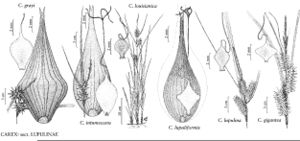Carex grayi
Amer. J. Sci. Arts, ser. 2, 4: 22. 1847.
Plants cespitose or not, short-rhizomatous. Culms solitary or not, erect, (25–) 40–90 (–110) cm. Leaves 6–12; basal sheaths purplish red; sheath of distal leaf 0–1.5 (–2.5) cm; ligules rounded, 2.5–6 mm; blades 12–34 cm × 4–11 mm. Inflorescences 2.5–17 cm; peduncles of proximal pistillate spikes 0.7–3.5 cm, basal 2 peduncles 1–4 (–12) cm apart; peduncle of terminal spike 0.5–6 cm; bracts leafy, usually sheathless, blades 8–26 cm × 2–7 mm. Spikes: proximal pistillate spikes 1–2 (–3), densely (4–) 8–35-flowered, separate to aggregated, globular, 2.5–4.2 × 2.6–4.1 cm; terminal staminate spike 1, 0.5–6.5 cm × 1–4 mm. Pistillate scales 1–5-veined, lanceolate-ovate to ovate-orbicular, 4–11 × 2–4.2 mm, apex obtuse to awned, awn to 7 mm, rough. Anthers 3, 2.5–4.8 mm. Perigynia radiating out in all directions, strongly 16–25-veined, rhombic-ovoid, 12.5–20 × 4–8 mm, base cuneate, dull, glabrous or, sometimes, hispidulous; beak poorly defined, 1.5–3 mm. Achenes sessile, ellipsoid to obovoid, faces convex, angles not thickened, 3.3–4.8 × 2.6–3.7 mm; style withering.
Phenology: Fruiting May–Aug.
Habitat: Mesic to wet deciduous forests, forest openings, usually on fine alluvial or lacustrine deposits, riverbottoms
Elevation: 0–500 m
Distribution

Ont., Que., Ala., Ark., Conn., Del., D.C., Fla., Ga., Ill., Ind., Iowa, Kans., Ky., Md., Mass., Mich., Minn., Miss., Mo., N.Y., N.C., Ohio, Okla., Pa., S.C., Tenn., Vt., Va., Wis.
Discussion
Pubescence on the perigynia of Carex grayi is most frequently found in plants from the Midwest and South.
Selected References
None.
Lower Taxa
"shortened" is not a number.
